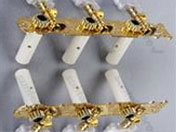Musical Steel Pegs
One of the most important parts on a variety of instruments, are the musical steel pegs. These are also calling tuning pegs, tuning pins, or musical pins. These are found on multiple string instruments, such as the violin. The musical steel pegs are to hold the strings on the instruments. By adjusting how tight or lose the string, which is attached to the peg, it adjusts the musical note, pitch, or sound, made by the instrument.
Instruments that have musical steel pegs
- Violin
- Guitar
- Fiddle
- Double bass (also called string bass, among other similar names)
- Santur (a string instrument dated back to Babylonian times)
- Bulgarian gadulka (similar to a violin)
- Hurdy Gurdy (also known as a wheeled fiddle)
Fundamentals of the musical steel pegs
The peg inside the peg box on an instrument should easily move or adjust, this will indicate that the peg is working correctly and doing what it is intended to do. It should not stick, or get stuck, while trying to turn and twist it. The steel pegs have different tapers used on different instruments. When the peg is slightly pulled out, it turns easier because of the taper, as well as it holds the peg more firmly when it is pushed in for tuning. The peg shaft tends to get worn down due to the movement against the taper, so sometimes the pegs will need to be refitted. The refitting process takes the steel pegs and the holes to smooth them out to a circular cone-like shape.
Musical steel pegs are stronger than other pegs
When working with an instrument, the best quality pegs will provide the best tuning results. The musical steel pegs are made of a very strong materiel, which will outlast those made of other materials. There are some that may still be very strong and work as well; however, steel is one of the strongest high quality pegs. You can find pegs made of rosewood, boxwood, ebony, or other materials. You may also find some that have decorations made of plastic, metal, shell, or rings and beads. This can dress up your pegs, but doesn’t provide any additional tuning benefit.
Musical steel pegs certainly are an important piece to tuning the instrument. Something to help use the steel pegs best would be peg dope. Peg dope is used on the steel pegs, a coating that is, and it helps with the tuning process by making the peg shaft easier to turn in, as well as creating a bit of friction so that the peg doesn’t slip on its own. When the steel pegs are correctly doped and fit well, the pegs will turn very easily but still stay firm in the peg shaft when the player wants them to. Tuning these steel pegs takes a bit of skill but will come with more practice. As the pitch of the instrument changes, a musician will become more familiar through trial and error of tuning the pegs, until its second nature.

